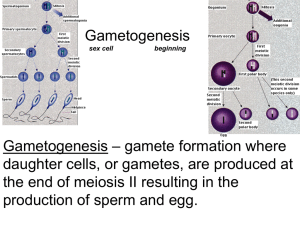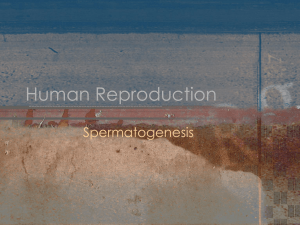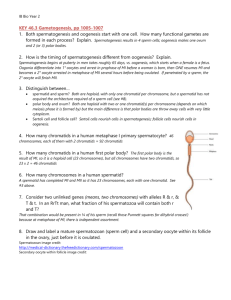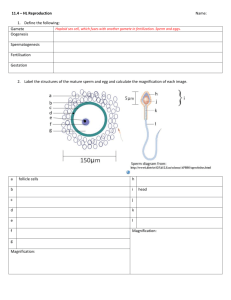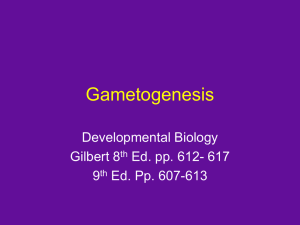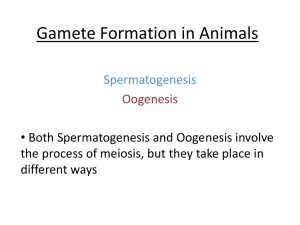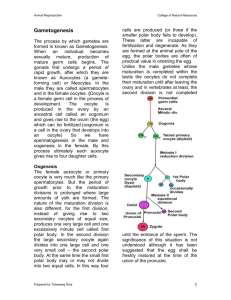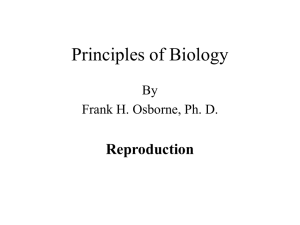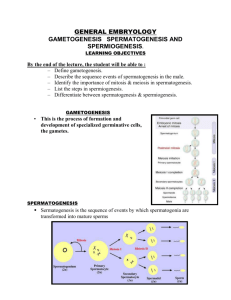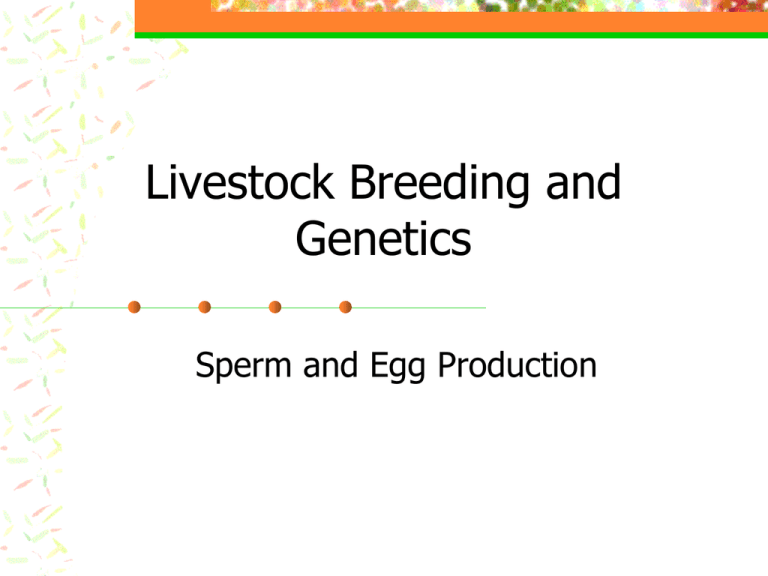
Livestock Breeding and
Genetics
Sperm and Egg Production
• We are beyond the mid-point of the
semester.
• What’s ahead:
- Livestock Breeding and Genetics
- Animal Health
- Livestock Pests
- Waste Management
In this lesson…
• Describe the difference
between oogenesis and
spermatogenesis.
• Describe the genetic
factors that influence the
sex of an offspring.
Some Main Points to Ponder:
• What are gonocytes and oocytes?
• Focus in on stage 2 of oogenesis and
the divisions that occur.
• Focus in on the divisions and products
thereof during spermatogenesis.
• How do males and females play a role
in sex determination of the offspring?
Big Picture of Today:
• Oogenesis: Creation of Eggs in female
livestock
• Spermatogenesis: Creation of Sperm in
male livestock
Oogenesis
• The process of the formation of eggs
with (GONOCYTES) OOCYTES
What are Gonocytes?
• The precursors of both
male and female gametes
(sex cells).
• Originate in the
embryonic animal during
its formation in the
womb.
What are Oocytes?
Microscopic Image of
Oocytes
• They are gonocytes that
have differentiated in the
fetal ovaries.
• They are the sole
reservoir of all future ova.
Growth of the oocyte (aka
Oogenesis)
Stage 1 - the OOCYTE grows in size
(lasts from birth to puberty)
Stage 2 - the OOCYTE and follicle
matures (during puberty)
Cell division
Occurs during Stage 2 of oogenesis
(previous slide)
1) The OOCYTE undergoes 2 meiotic
divisions during which 2 daughter cells
arise, each having half the chromosome
complement.
So what about these daughter cells….
• One of these 2 daughter cells acquires
nearly all of the cytoplasm, and this
large cell is called the SECONDARY
OOCYTE.
• The much smaller cell with only a little
cytoplasm is called the POLAR BODY.
2) At the second maturation division, the
SECONDARY OOCYTE divides into the
OOTID and a second POLAR BODY.
3) The POLAR BODIES degenerate,
leaving the OOTID ready for
fertilization.
Oogenesis: Big Picture
FYI
• The OOTIDS or OVUM actually undergo
oogenesis at different times, depending
on the species.
Moving forward to:
Spermatogenesis
• The process of sperm formation which
commences at puberty.
• At birth, SPERMATOGONIA are present
• These SPERMATOGONIA also are called
SPERM MOTHER CELLS.
Phases of Spermatogenesis
• SPERMATOGONIA undergo mitotic
division and become dormant, thus
ensuring a continuous supply of
SPERMATOGONIA.
• One SPERMATOGONIUM becomes
active and divides 4 more times so that
there are now 16 PRIMARY
SPERMATOCYTES.
These primary spermatocytes go through
meiotic division.
• At this time, the number of
chromosomes is HALVED
• These new cells are now called
SECONDARY SPERMATOCYTES
• The secondary spermatocytes undergo
one more division to become
SPERMATIDS.
• SPERMATIDS undergo a metamorphosis
which involves a radical alteration in
cellular form during which most of the
cytoplasm is lost.
Spermatogenesis: Big Picture
Sex Determination
• Every cell in the mammalian body,
except the gametes (sperm and ova),
contains a pair of sex chromosomes
• In females, the 2 members of the sex
chromosome pair resemble one another
and are known as the X chromosomes
(XX).
• In males, the sex chromosomes differ
from one another, one is the X
chromosome, the other is smaller and is
called the Y chromosome (XY).
• The gametes contain only a single sex
chromosome:
In the female, each ovum contains an X
chromosome.
In the male, the sperm contains either an
X or a Y chromosome.
Determination:
• In normal fertilization, the embryo
develops as a male or female according
to whether the ovum is fertilized by a
sperm carrying an X or a Y
chromosome. In effect, the father
determines the sex of the offspring.
What influences the sex of the
offspring?
• If the 2 types of sperm are present in
equal numbers, the ratio of male to
female sperm at the time of conception
should be 1:1.
• The sex of the offspring is important to
many livestock producers since one sex
may be more valuable than the other.
For example:
1) beef cattle - steers bring a higher
market price than heifers;
2) dairy cattle - heifers are the milk
producers so they are more valuable
than bull calves; and
3) poultry - egg production operations
keep all the laying hen chicks, but often
dispose of the male chicks.
Let’s Review
• What are gonocytes and oocytes?
• What divisions occur in stage 2 of
oogenesis?
• What were the divisions and products
thereof during spermatogenesis?
• How do males and females play a role
in sex determination of the offspring?
Sources
• California Ag Ed Tech Prep
• Scientific Farm Animal Production: An
Introduction to Animal Science

